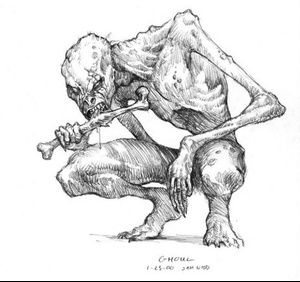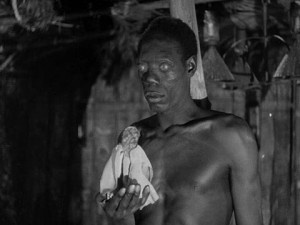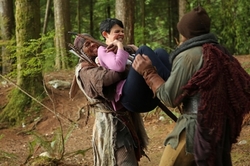|
Enchanted Zombies Teresa Martin--@Teresa__Martin There have been many fantastical creatures to which fans of Once Upon a Time have been treated including ogres, wraiths, and dragons, to name a few. The most recent monsters to visit the Enchanted Forest have been zombies, presented with the now classic Once Upon a Time twist. The history of these creatures encompasses an extensive lore originating from the earliest civilizations in all continents. However, zombies, explicitly as they are named and most well known in the Twenty-First Century, have traced their roots directly from Voodoo traditions in Haiti. It is these upon which the writers of Once Upon a Time drew for their incarnation and lead to the reason why these creatures are not merely a random choice, but rather most appropriately featured in the Season Two story arc. The word “zombie” is defined by Brad Steiger as “a reanimated corpse . . . brought to life to serve as slave labor.” The belief that such beings exist was brought from Africa to the Caribbean and Southern states by the slaves who practiced Voodoo. “Voodoo holds that a supernatural power or essence may enter into and reanimate a dead body (Steiger 5-6).” The more ancient incarnations of this creature were chronicled in the History Channel documentary Zombies: A Living History which includes the Chinese Jiang Shi, a corpse brought back to life (Abramowitz). This undead predator hops about and pounces on humans, feeding on their life-essence. Human victims of the Jiang Shi will resurrect and become the very creatures which brought about their deaths (Radford). Also listed by the documentary is the Arabic Ghoul, a demon that eats human victims, the Draugr of Scandinavia that swallows its victims whole, and the Revenant of England which terrorizes family members and shares many characteristics with a vampire. An ancient source mentioned in Zombies is The Epic of Gilgamesh in which Ishtar wishes for the Bull of Heaven to kill Gilgamesh. He declares in Tablet VI: "If you do not give me the Bull of Heaven, I will knock down the Gates of the Netherworld, I will smash the door posts, and leave the doors flat down, and will let the dead go up to eat the living!” A modern and unique manifestation of this tradition is found in the practice of Voodoo. Zombies in Haiti were not viewed as antagonists but rather victims of those who wield control over their dead bodies for purposes akin to slavery. They were made zombies through magic by bokors, the equivalent of a “witch doctor” (Radford). A dark and fearsome magic was wielded, according to local belief. An attempt to explain how this could have occurred naturally holds that this process happened when the bokor created the ultimate zombie cocktail full of various poisons that would cause a person to appear dead, be buried alive, and then dug-up. The trauma of the experience and the mind-altering drugs could leave a person in a “zombie state” and susceptible to commands (Harrington). Whether it is the supernatural or a marvelous combination of drugs, the belief in the bokor’s ability to control a person using this process is not disputed. Another question posing itself in the scene is why the writers of Once Upon a Time chose this plot device. A cynical answer would be that they noticed the popularity of zombies, so why not? A closer examination however reveals their inclusion as consistent with the show’s mission to celebrate and entertain audiences by combining the old and new in a manner that speaks to a contemporary audience. Therefore, how could they not include zombies? These popular creatures mirror both the fears and comforts of the viewers in a fragile time. It is an unquestionable assertion that humanity is in a brave new world of scientific, political, and economical experimentation made paradoxically capable by the very advances in these areas of study, thus leaving people without any certainty of the outcome. Humanity may be facing ruin in an apocalyptic destruction, or, as the more optimistic assert, a better world, which many call “Utopia.” This latter can give hope until one remembers that the work Utopia by Sir Thomas More was based upon a pun of the Greek word which means “no place.” Thomas More perhaps wrote more than he knew, since he who wrote about the perfect society met his end with an execution because he refused to betray his conscience. No “Utopia” for the writer of Utopia. Therefore even that comfort is denied those in a changing world in which nothing is certain except the knowledge that nothing is certain. Into this society of ambiguity and loss of control, enter the zombies. James Turner suggested this in a Forbes article: “Americans must like the idea that, as out of control as our hubristic science might become, a good machete and a 12 gauge in the hands of a competent man or woman can always save the day.” Once Upon a Time hence not only created a new twist on the zombie, but also illustrated the comfort described in the Forbes quote by having, of all people, Disney princesses take up their weapons in order to defeat the monsters. The fairy-tale world of “normal” had already been taken from them as it has with humanity. Normal has become survival in an age of asymmetrical warfare. Whether one is the average blue-collar worker or a princess, roles have changed, and ultimately people must take charge of their own fates and prevail if they are willing to fight for it. The princesses do this with flair and efficiency. With the airing of “Into the Deep,” Once Upon a Time continues its tradition of telling “tales as old as time,” but not necessarily fairy tales as old as time. Yet the zombie beasts resurrected by evil sorcerers illustrate the same magic that one may see the Evil Queen in “Snow White” commit, and has roots as deep in anthropological morality tales as any fable put to paper by the Grimm brothers or Charles Perrault. The fascination with death, resurrection, and fighting for those one loves is a hallmark of zombie stories both in fiction and in the beliefs of the ancients. Once Upon a Time makes these stories its own and mingles them from every world culture. The question fans now face is the speculation of what new creatures will the creators bring to their fictional worlds from the archives of humanity’s unconscious mythological memories? Moreover, will there be a princess, a prince, or a cross-bow wielding Granny who will defend them? These are stories waiting to be told, and to which the viewers can anticipate in the episodes to come. Works Cited Abramowitz, Andre et al. Zombies: A Living History. Dir. David Nicholson. Narr. Peter Outerbridge. History Channel, 2011. DVD. Beaufortninja. “Jiang Shi: The Chinese Zombie.” Wandering American. http://wanderingamericantravelblog.com/2012/04/04/jiang-shi-the-chinese-zombie. April 4, 2012 Harrington, Thomas van. “Zombie Secrets.” http://www.zombiesecrets.com/p1002.html Radford, Benjamin. “A History of ‘Real’ Zombies.” Discovery News. http://news.discovery.com/history/history-zombies-12-6-4.html June 4, 2012. Steiger, Brad. Real Zombies: The Living Dead, and Creatures of the Apocolypse. Canton, MI: Visable Ink Press, 2010. Turner, James. “A Brief History of Zombies.” Forbes.com. June 30, 2009. http://www.forbes.com/2009/10/29/oreilly-godzilla-science-technology-breakthroughs- zombies.html
0 Comments
Leave a Reply. |
OriginsExplore the Arthurian legend surrounding Lancelot, take a trip into the woods to discover the mythology behind Red Riding Hood or learn more about a modern day hero called Snow White. Origins provides unique insights and perspectives from talented writers into the characters we know and love, going far beyond the boundaries of Storybrooke. Archives
August 2016
Categories
All
|




